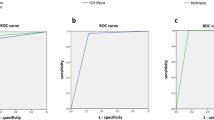Abstract
Purpose
To determine the presence of OC-125 staining in endometriotic lesions and to verify whether there is an association with endometriosis stage.
Methods
Thirteen patients from the Family Planning programs (group I) and 53 patients from the Chronic Pelvic Pain outpatient clinic (group II) were studied. Endometriotic lesions were excised from areas of endometriosis incidence and studied by histopathological assay and by immunohistochemistry for OC-125 staining.
Results
The histopathological study disclosed that all patients from group I had minimal/mild endometriosis. In group II, 39.6% had minimal/mild endometriosis, and 60.4% had moderate/severe endometriosis. OC-125 staining was negative in all samples from group I. In group II, OC-125 staining was positive in 52.4% patients with minimal/mild endometriosis and in 81.2% with moderate/severe endometriosis.
Conclusion
The data suggest that the OC-125 antibody is probably related to endometriosis activity and, consequently, to the progression and severity of the illness.

Similar content being viewed by others
References
Renner SP, Strick R, Oppelt P, Fasching PA, Engel S, Baumann R et al (2006) Evaluation of clinical parameters and estrogen receptor alpha gene polymorphisms for patients with endometriosis. Reproduction 131:153–161. doi:10.1530/rep.1.00787
Vigano P, Gaffuri B, Somigliana E, Busacca M, Di Blasio AM, Vignali M (1998) Expression of intercellular adhesion molecule (ICAM-1) mRNA and protein is enhanced in endometriosis versus endometrial stromal cells in culture. Mol Hum Reprod 4:1150–1156. doi:10.1093/molehr/4.12.1150
Mehmud G, Akhtar T, Sadia S (2007) Endometriosis: frequency and correlation between symptomatology and disease stage. J Coll Physicians Surg Pak 17(4):199–202
Giudice LC, Kao LC (2004) Endometriosis. Lancet 364:1789–1799. doi:10.1016/S0140-6736(04)17403-5
Rosa e Silva AC, Rosa e Silva JC, Ferriani RA (2007) Serum CA-125 in the diagnosis of endometriosis. Int J Gynaecol Obstet 96(3):206–207. doi:10.1016/j.ijgo.2006.11.016
Matalliotakis IM, Goumenou AG, Mulayim N, Karkavitsas N, Koumantakis EE (2005) High concentrations of the CA-125, CA 19-9 and CA 15-3 in the peritoneal fluid between patients with and without endometriosis. Arch Gynecol Obstet 271(1):40–45. doi:10.1007/s00404-004-0645-7
Abrão MS, Podgaec S, Filho BM, Ramos LO, Pinotti JA, de Oliveira RM (1997) The use of biochemical markers in the diagnosis of pelvic endometriosis. Hum Reprod 12(11):2523–2527. doi:10.1093/humrep/12.11.2523
Bast RC Jr, Badgwell D, Lu Z, Marquez R, Rosen D, Liu J et al (2005) New tumor markers: CA125 and beyond. Int J Gynecol Cancer 15(Suppl 3):274–281. doi:10.1111/j.1525-1438.2005.00441.x
Bast RC, Feeney M, Lazarus H, Nadler LM, Colvin RB, Knaap RC (1981) Reactivity of a monoclonal antibody with human ovarian carcinoma. J Clin Invest 68:1331–1337. doi:10.1172/JCI110380
Appleyard TL, Mann CH, Khan KS (2006) Guidelines for the management of pelvic pain associated with endometriosis: a systematic appraisal of their quality. BJOG 113(7):749–757. doi:10.1111/j.1471-0528.2006.00937.x Review
Shaw RW (1993) An atlas of endometriosis. The Parthenon Publishing Group, Casterton Hall, Carnforth
The American Fertility Society (1997) Revised American Society for Reproductive Medicine Classification of Endometriosis: 1996. Fertil Steril 67:817–821. doi:10.1016/S0015-0282(97)81391-X
Hoeger KM, Guzick DS (1999) An update on the classification of endometriosis. Clin Obstet Gynecol 42(3):611–619. doi:10.1097/00003081-199909000-00015
Abrão MS, Neme RM, Carvalho FM, Aldrighi JM, Pinotti JA (2003) Histological classification of endometriosis as a predictor of response to treatment. Int J Gynaecol Obstet 82:31–40. doi:10.1016/S0020-7292(03)00079-1
Gimeno EJ, Massone AR, Portiansky EL Introducción a las técnicas de inmunohistoquímica y aplicaciones en patología veterinaria. In: Decimo Curso Internacional de Posgrado en Tecnicas de Inmunohistoquimica, Lectinhistoquimica y Microscopia Eletronica—Apostila. Universidad Nacional de La Plata, La Plata, Argentina, 1999. pp 61–111
Dessole S, Farina M, Rubattu G, Cosmi E, Ambrosini G, Nardelli GB (2003) Sonovaginography is a new technique for assessing rectovaginal endometriosis. Fertil Steril 79(4):1023–1027. doi:10.1016/S0015-0282(02)04952-X
Stratton P, Winkel C, Premkumar A, Chow C, Wilson J, Hearns-Stokes R et al (2003) Diagnostic accuracy of laparoscopy, magnetic resonance imaging, and histopathologic examination for the detection of endometriosis. Fertil Steril 79(5):1078–1085. doi:10.1016/S0015-0282(03)00155-9
Kitawaki J, Ishihara H, Koshiba H, Kiyomizu M, Teramoto M, Kitaoka Y et al (2005) Usefulness and limits of CA-125 in diagnosis of endometriosis without associated ovarian endometriomas. Hum Reprod 20(7):1999–2003. doi:10.1093/humrep/deh890
O’Brien TJ, Raymond LN, Bannon GA, Ford DH, Hardardottir H, Miller FC et al (1991) New monoclonal antibodies identify the glycoprotein carring the CA-125 epitope. Am J Obstet Gynecol 165:1857–1864
Amaral VF, Ferriani RA, Sá MF, Nogueira AA, Rosa e Silva JC, Rosa e Silva AC et al (2006) Positive correlation between serum and peritoneal fluid CA-125 levels in women with pelvic endometriosis. Sao Paulo Med J 124(4):223–227. doi:10.1590/S1516-31802006000400010
Koninckx PR (1994) Is mild endometriosis a condition occurring intermittently in all women? Hum Reprod 9(12):2202–2205
Vercellini P, Trespidi L, Panazza S, Bramante T, Mauro F, Crosignani PG (1996) Laparoscopic uterine biopsy for diagnosing diffuse adenomyosis. J Reprod Med 41(4):220–224
Nisolle M, Nervo P (2003) Physiopathology and therapeutic management of stage I and II endometriosis. J Gynecol Obstet Biol Reprod (Paris) 32(8 Pt 2):S11–S14
Moen MH, Muus KM (1991) Endometriosis in pregnant and non-pregnant women at tubal sterilization. Hum Reprod 6(5):699–702
Arici A, Oral E, Attar E, Tazuke SI, Olive DL (1997) Monocyte chemotactic protein-1 concentration in peritoneal fluid of women with endometriosis and its modulation of expression in mesothelial cells. Fertil Steril 67(6):1065–1072. doi:10.1016/S0015-0282(97)81440-9
Toki T, Kubota J, Lu X, Nakayama K (2000) Immunohistochemical analysis of CA125, CA19-9, and Ki-67 in stage III or IV endometriosis: positive correlation between serum CA125 level and endometriotic epithelial cell proliferation. Acta Obstet Gynecol Scand 79(9):771–776. doi:10.1034/j.1600-0412.2000.079009771.x
Agic A, Xu H, Finas D, Banz C, Diedrich K, Hornung D (2006) Is endometriosis associated with systemic subclinical inflammation? Gynecol Obstet Invest 62(3):139–147. doi:10.1159/000093121
Cho S, Cho H, Nam A, Kim HY, Choi YS, Park KH et al (2008) Neutrophil-to-lymphocyte ratio as an adjunct to CA-125 for the diagnosis of endometriosis. Fertil Steril 90(6):2073–2079. doi:10.1016/j.fertnstert.2008.03.061
Conflict of interest statement
None.
Author information
Authors and Affiliations
Corresponding author
Rights and permissions
About this article
Cite this article
Barbosa, C.P., de Souza, Â.M.B., Bianco, B. et al. OC-125 immunostaining in endometriotic lesion samples. Arch Gynecol Obstet 281, 43–47 (2010). https://doi.org/10.1007/s00404-009-1055-7
Received:
Accepted:
Published:
Issue Date:
DOI: https://doi.org/10.1007/s00404-009-1055-7




